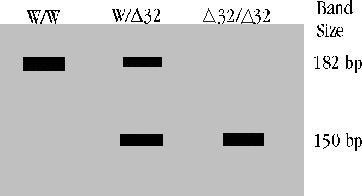Volume 3, Number 3—September 1997
Perspective
Host Genes and HIV: The Role of the Chemokine Receptor Gene CCR5 and Its Allele (∆32 CCR5)
Figure 3

Figure 3. Differentiation of CCR5 genotypes by gel electrophoresis. Band patterns of persons with homozygous wild type (W/W), homozygous 32 bp deletion (∆32/∆32) or heterozygous W/∆32 CCR5 genotypes are shown. PCR amplification of the C-terminal of the CCR5 gene, subsequent digestion with the EcoRI restriction enzyme, and agarose gel electrophoresis of the digested DNA yield a 182 bp band for the wild type CCR5 gene, a 150 bp band for the 32 allele, and both bands in the case of a heterozygous person.
1Garred P, Eugen-Olsen J, Iversen AKN, Benfield TL, Svejgaard A, Hofmann, B, the Copenhagen AIDS Study Group. Dual effect of CCR5 D32 gene deletion in HIV-1-infected patients. Lancet 1997; 349:1884.
2Martinson JJ, Chapman NH, Rees DC, Lui Y-T, Clegg JB. Global distribution of the CCR5 gene 32-basepair deletion [letter]. Nature Genetics 1997;16:100-103.
3Centers for Disease Control and Prevention. Facts about CCR5 and protection against HIV-1 infection; 1997.